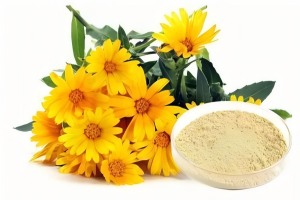Chrysanthemum Extract:Natural support for skin and vision

Chrysanthemum extract is derived from the flowers of the Chrysanthemum morifolium plant, a species widely used in traditional herbal systems, especially in East Asia. Known for its calming properties, this botanical ingredient has become increasingly popular in modern supplements, skincare products, and functional beverages.
Origin and Traditional Uses
The chrysanthemum flower has been cultivated for centuries, especially in China and Japan, where it is both a cultural symbol and a medicinal resource. Historically, it has been used to relieve headaches, reduce fever, and support vision health. The extract is usually made by drying the flowers and extracting their beneficial compounds using hot water or ethanol.
Forms of Consumption
Traditionally, chrysanthemum is consumed as a tea made from dried flowers. In modern applications, concentrated extracts are used in capsules, powders, tinctures, and topical formulations. Each form offers different levels of potency and bioavailability.
Active Compounds in Chrysanthemum Extract
The health benefits of chrysanthemum extract are linked to its rich profile of flavonoids, phenolic acids, and essential oils. These natural compounds exhibit antioxidant, anti-inflammatory, and antimicrobial properties.
Flavonoids and Antioxidants
Key flavonoids like luteolin and apigenin contribute to the extract’s ability to neutralize free radicals. These antioxidants help protect cells from oxidative stress, which can contribute to premature aging and chronic disease.
Volatile Oils and Terpenes
Essential oils from chrysanthemum contain camphor, borneol, and cineole. These compounds give the extract its distinctive fragrance and offer additional therapeutic effects, including mild analgesic and antimicrobial action.
Health Benefits and Applications
Chrysanthemum extract has been investigated for a range of physiological effects. Its benefits span internal wellness and topical skincare, making it a versatile natural ingredient in both health and cosmetic industries.
Eye and Vision Support
In traditional medicine, chrysanthemum is used to support eye health, particularly for fatigue, dryness, or blurred vision. Modern studies suggest that its antioxidant compounds may help reduce oxidative stress in ocular tissues.
Immune Regulation
Chrysanthemum extract has mild immunomodulatory effects. It helps the body maintain a balanced immune response, especially during seasonal changes or times of physical stress.
Skin Calming Properties
In skincare, chrysanthemum extract is used for its soothing effect on irritated or sensitive skin. It is commonly added to creams, serums, and facial mists designed for redness or inflammation-prone skin.
Integration into Modern Wellness Routines
Today, chrysanthemum extract is increasingly incorporated into consumer products targeting health-conscious audiences. Brands are leveraging its heritage and bioactivity to formulate products that align with natural wellness trends.
Dietary Supplements
Available in tablet, capsule, and liquid forms, chrysanthemum extract is often marketed for eye health, stress relief, and immune balance. It is sometimes blended with other herbs like goji berry or ginseng for synergistic effects.
Functional Beverages
Chrysanthemum-based teas and drinks are widely sold in East Asian markets and are gaining traction globally. They are appreciated for their floral flavor and gentle effects on the nervous system.
Natural Cosmetics
Beauty brands include chrysanthemum extract in formulations for its calming and anti-aging properties. It is particularly valued in products meant for sensitive or redness-prone skin types.
Sourcing and Quality Considerations
Quality depends on the origin of the flower, method of cultivation, and extraction process. Organic and wildcrafted sources are often preferred for their purity and lack of chemical residues.
Standardized Extracts
To ensure consistency, reputable manufacturers standardize their chrysanthemum extracts based on flavonoid content. This allows for more predictable therapeutic effects across batches.
Sustainability and Ethical Harvesting
With growing demand, sustainable cultivation practices are essential. Farmers are adopting crop rotation and organic growing methods to meet both ecological standards and consumer expectations.


